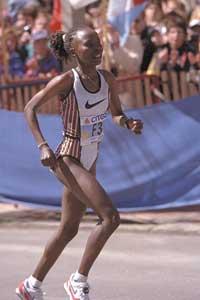Athletes: hormones yes, but in exchange for what?
It seems that doping is not XX. The invention of the twentieth century, let alone. To find the first traces of doping, a. C. C. IV. It is the year in which sport begins to have a great importance in Greek society. Around the sport competitions many people met and the prizes that the winners received were of no kind. In addition to money, athletes could get other privileges such as food or housing. But that wasn't all; the next prizes, surely, were much more attractive: to get rid of taxes and military service.
Looking at the prizes, it is not surprising that many athletes want to cheat and give a push to their abilities. Although there were no sophisticated current hormones, the Greeks knew well that some mushrooms and vegetable extracts were missing and gave strength. Finally, the use of these substances extended so much that one of the main causes of the disappearance of the former Olympic Games was the abusive use of stimulating substances.

After the Greeks came the Roman era. The main games of then were horse races and gladiator fights, in which the use of drugs was very widespread. They gave the horses substances that gave them strength to move faster. The gladiators, for their part, were provided with drugs that allowed them to have strength to fight strongly against the lions, to satisfy the appetite for blood of the spectator and to ensure the spectacle.
After the Greeks and Romans, however, came the time of Christianity and the sport came the time to live the darkest years of history. On the one hand, Christians did not accept the violent and bloody Roman games or the pagan Greek Olympics. On the other hand, they considered that physical training made intellectual development difficult.
For all this, the sport was totally excluded for centuries. XIX. In the twentieth century, several rural works began to become a competition to show the strength and skill of the participants, so that little by little the sport began to become important.
Over the years, the fame of the sport has grown steadily, going from being a hobby to being a business. In addition, it has acquired great social relevance. The successes in the sport are very good for everyone. Faced with this pressure, athletes are preparing to be the best of the best. That is not achieved from one day to another. Often, as much as you strive, it is impossible to be the best of the best. In these cases it is to thank the external collaboration. Hormones, for example.
What can hormones help?
So that athletes try to clarify the reason for the use of hormones. In fact, hormones are chemical messengers that regulate different functions of the body. They form in the glands and are distributed throughout the body through the blood. Despite its low concentration, it is sufficient to correct most of the processes that are given in the body. They largely control the growth and development of organs and tissues, which has made them targets for many athletes. In addition, at present, the recombined DNA technology allows the synthesis of many hormones, which facilitates their obtaining in large quantities without major problems.

There are many hormones that athletes use, but among bodybuilders, for example, anabolic steroids are the most used. They are similar to testosterone. It occurs in male testicles and, to a lesser extent, in female ovaries. In puberty and adolescence, he is largely responsible for the changes that occur in development.
As testosterone influences muscle growth, increasing the amount of testosterone in the blood, athletes can increase the size, solidity, and strength of their muscles, and athletes, in turn, argue that it accelerates recovery after injury. But this has other consequences, such as increasing the number of hair in the body and increasing the voice, especially in the case of women, which have not been announced. Therefore, scientists have made a great effort to develop steroids with anabolic effects but with lower androgenic effect, such as androstenedione or nandrolone. Growth hormone, also called somatotropin, promotes physical development in adolescence, especially bone growth. It produces a synthesis of collagen that is needed to strengthen cartilages, bones, tendons, and ligaments. It stimulates the degradation of fat while promoting the development of muscle mass in order to use it as a source of energy.
On the other hand, it increases the number of red blood cells in adults and stimulates the functions of the heart. Therefore, it is easy to understand why it is interesting for athletes. In humans, the factors that stimulate the spontaneous production of this hormone are sleep, physical exercise, and stress.
However, other sports modalities have other needs. In them a muscular increase is not required but a fast energy source and a greater oxygen capacity. Of those who have this effect, probably the most used are erythropoietin and insulin.
Erythropoietin (EPO) was first unveiled in 1998, when in the Tour de France the components of the Festina cycling team were trapped and expelled with erythropoietin and other prohibited substances. Erythropoietin is originated by the kidney and stimulates the production of red blood cells in the bone marrow. Red cells, with the help of hemoglobin, carry oxygen to the other cells, even to the muscles. Therefore, by increasing the production of red cells in the blood, the amount of oxygen that reaches the muscles will be increased, allowing it to be done aerobically. For this reason, it is a very used sport. In medicine it is used to treat anemias associated with renal diseases, while athletes can increase their aerobic capacity by injecting EPO.

As has already been mentioned, it is evident that in many sports a quick source of energy is needed: glucose. But glucose, to cross the cell membrane and be used internally, needs a specific transport system. Many times this is the limiting factor. Under normal conditions, in the cell membrane there are as many transporters as they ensure the amount of glucose necessary for the cell's breathing to occur smoothly, and the glucose input depends on the glucose gradient on the outside and inside of the cell.
In the case of the muscle, in addition to these, a special conveyor called Glut-4 appears. It is an inductive glucose transporter, which appears in the membrane only in response to insulin and muscle contraction. Insulin causes the translocation of the glucose transporter Glut-4, which transports from the cytoplasm of the muscle tissue to the plasma membrane. This increases the rate of penetration of glucose.
However, even though glucose is an important source of energy, too much blood glucose can be very dangerous. When it detects the entry of more glucose to cells than is necessary for breathing, insulin produces glycogen. It is known that the performance of medium-distance runners largely depends on the muscular supply of glycogen. To fill your muscles with glycogen fuels, there are those who take high doses of glucose and insulin. This technique, called hyperinsulinaemic clamp, will cause all glucose received to become glycogen. Thanks to this, athletes will have a very high level of glycogen in muscle cells, ready for the start of the sport. This will become glucose as soon as you start practicing sports, without the need for excessive blood glucose levels from the beginning. Surprisingly, this technique can multiply by 12 glucose metabolism.
How can the administration of hormones be detected?
Some athlete has been disqualified on several occasions in the history of the Olympic Games for the use of prohibited substances. Ben Johnson himself, by withdrawing the gold medal for positive anabolic steroid tests at the Olympic Games, acknowledged that for many years he had been uniting steroids and growth hormone.

But the biggest difficulty to detect that an athlete has taken hormones is that the human being itself also produces them naturally. How to distinguish between natural and exogenous? Many times excessive concentration can be detected, but it is usually difficult to determine the concentration considered normal, since not all people have the same hormonal concentration. In addition, for the hormone detection test to be useful, it must be simple, fast and economical and the most efficient tests are usually very expensive. They usually perform urine and blood tests.
Often the so-called mass spectroscopy is used to distinguish between natural and synthetic hormones. This technique can differentiate compounds containing different carbon isotopes, such as natural and synthetic testosterone, as there is a small difference in size between them. On other occasions, the load differences between two molecules are the ones that allow us to know if the hormones detected are exogenous. For this purpose the technique called isoelectrofocus is used.
On the other hand, in general, hormones are rapidly eliminated in the body. For this reason, athletes abandon the administration of hormones before performing large sports tests to make their detection difficult and, as a way of detection, techniques have had to be developed that measure the concentration of metabolites that occur as a result of this degradation.
Each hormone presents different difficulties when detecting them, but all go in the same line. In the case of growth hormone, for example, in recent times European endocrinologists and scientists are involved in the project called GH-2000 in the search for a technique of high sensitivity and reliability that allows to verify with certainty that an athlete has taken the growth hormone.
What risks do you have to take hormones?Despite its great use in medicine, excessive consumption and, above all, consumption without a strong medical coltrol can cause serious bodily damage. In any case, to strengthen the body, people who take it should know what dangers they are going through, because it is one of those deaths. For example, long-term use of anabolic steroids can increase blood pressure, cause acne, and cause problems with liver function. In addition, it can cause menstrual alterations in women, reduce sperm production and induce impotence in men and promote the appearance of renal and cardiac diseases. In addition, it usually generates an aggressive behavior. Among the growth hormone receptors, several diseases have been observed. One of them is acromegalia, which usually produces an excessive growth of heads, feet and hands. The growth of the lip, nose, tongue, gag and forehead are easily noticeable in your face. The digestive system also increases in size and often produces failures in the functioning of the heart. Therefore, acromegalates usually die before 40 years. When the concentration of erythropoietin is excessive, excessive red blood cells occur, which can cause blood clotting. It has been the cause of the death of many athletes. Insulin abuse can also cause serious problems in the health of athletes. Staying the brain without the energy and oxygen needed by excess glucose in the blood can send the insulin receptor to an irreversible coma. |
For the 2004 Olympic Games, a chip for detecting prohibited substances!For the next Olympic Games a chip can be prepared that detects the excessive consumption of prohibited substances. This way you can combine hundreds of tests in a few hours, which will allow all athletes to try if they decide to use them. Until now several athletes were selected and tested, since there was not enough time to perform the test at all, there was no money. But from now on no athlete would be released, everyone will have to do the test. This can take away from your head the idea of taking abusive hormones and put all athletes at the same level. The chip developed in the Randox Laboratories will have a width of one centimeter and will detect 25 substances. To do this, they will use a system of detection by antibodies that will allow them to know the specific hormones and metabolites that are generated in the body through its degradation. Being a fast method, tests can be done at any time. However, Roisin Molloy, from the Randox Laboratory, has commented that it will serve to carry out a first analysis, since then it will have to confirm the results of the samples suspected of taking prohibited substances. For the time being, anabolic steroid tests have been included in the chip they have called Evidence, but have manifested their intention to increase their penetration. In addition, despite the fact that urine is currently being analyzed, those responsible for conducting the tests have indicated that in the Olympic Games, the possibility of doing it through saliva would greatly facilitate the nervousness of athletes, who sometimes hinder the collection of urine samples. |





